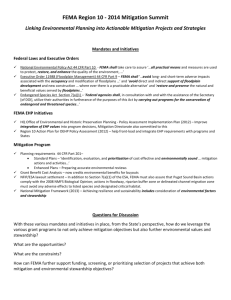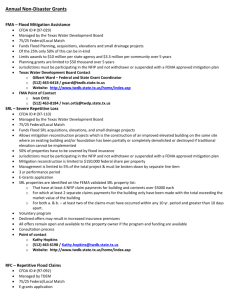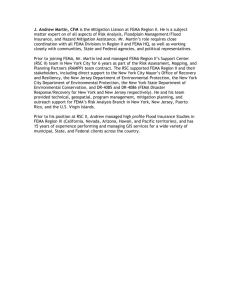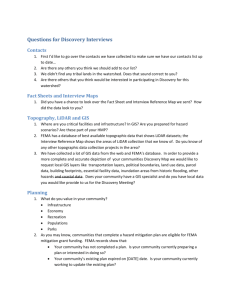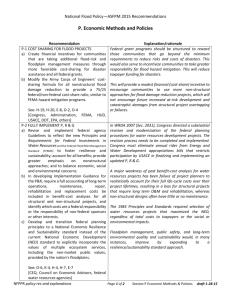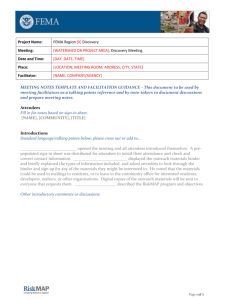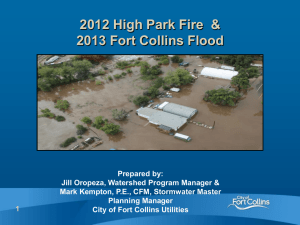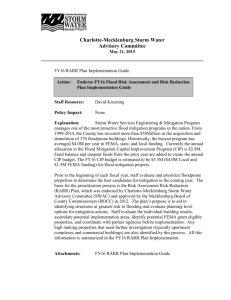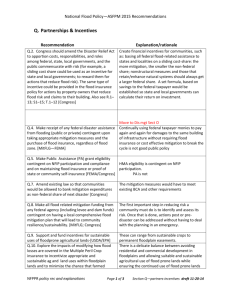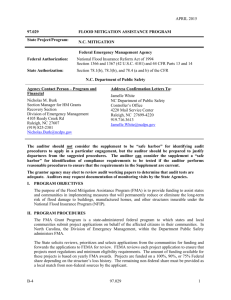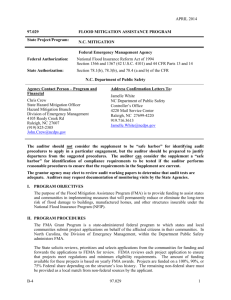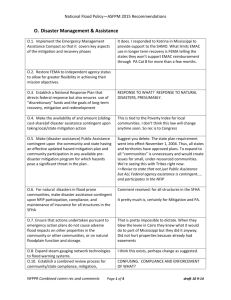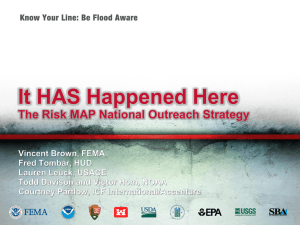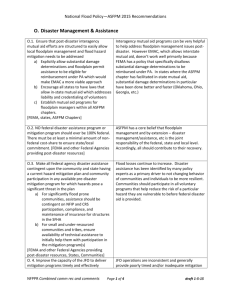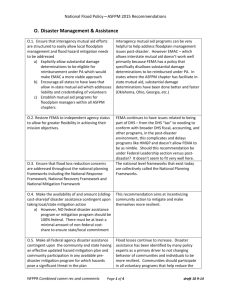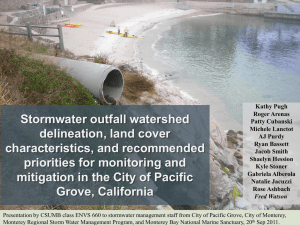Risk MAP Discovery Meeting - Starr
advertisement
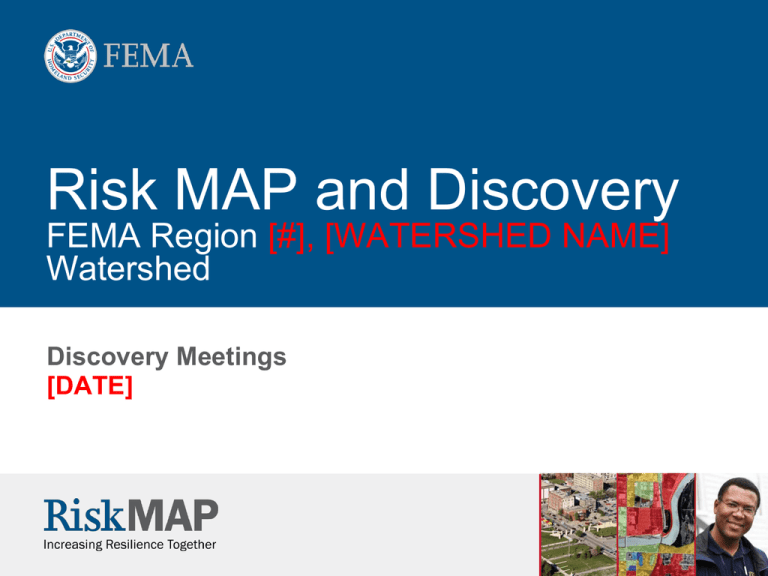
Risk MAP and Discovery FEMA Region [#], [WATERSHED NAME] Watershed Discovery Meetings [DATE] Meeting Agenda Welcome! Brief Overview of Risk MAP and Discovery Breakout Sessions – Interactive Discussions • Session A – Mapping Needs Location, Study Level, Reason, Priority • Session B – Other Flood-Related Concerns Levees, Data, ESAs, Funding Mitigation Planning and Projects Compliance and Communications Close 2 Overview: Risk MAP • Five year effort to modernize maps • Result: digital flood data and digital maps for 92% of population • Improved flood data quality • Limited up-front coordination • Scoping not mandatory • Collaborative approach • Goals: quality data, public awareness, action that reduces risk • Watershed-oriented • Focus on up-front coordination • Discovery is mandatory 3 The Vision for Risk MAP Through collaboration with State, Local, and Tribal entities, Risk MAP will deliver quality data that increases public awareness and leads to action that reduces risk to life and property 4 Risk MAP Products Changes Since Last Map • Improved outreach • Increase transparency and trust Multi-Frequency Depth & Water-Surface Elevation (WSE) Grids Inundation 3 feet or less 10%, 2%, 1%, 0.5%, 0.2% annual chance profiles 3 to 6 feet 6 feet + 5 Risk MAP Products HAZUS Risk Assessment & National Flood Risk Layer Enables communities to understand risk by reference to existing structure loss Contributing Flood Hazard Factors Highlights areas of concern identified throughout project 6 Risk MAP DFIRM/FIS FIS Reports and DFIRM Maps will continue to fulfill regulatory requirements and support the NFIP 7 Discovery Discovery is the process of data mining, collection, and analysis with the goal of initiating a flood risk or mitigation project and risk discussions with the watershed When: • After an area/watershed has been prioritized • Before a Risk MAP project is scoped or funded Required for new and updated… • Flood studies • Flood risk assessments • Mitigation planning technical assistance projects Why: • Increases visibility of flood risk information, education, involvement • Helps inform whether a Risk MAP project will occur in the watershed 8 Discovery Process Federal and State Data Collection Information Exchange: [DATES] • Risk MAP Overview • Local Issues Questionnaire: Identify Risk MAP Needs Discovery Meetings: [DATES] Risk MAP Project(s) Identified FEMA Funding Allocated for Risk MAP Project 9 Information Exchange Information Exchange: Results or Questionnaire/Form Discuss Review/update information Leave with us when you leave 10 Discovery Breakout Sessions Breakout Session A – Mitigation, Compliance, Communication • Levees • Existing Data Studies • Funding • Data • Mitigation Planning • Desired Mitigation Projects • Environmentally Sensitive Areas • Communications and Outreach • Compliance and Training Breakout Session B - Desired Study Areas/Mapping Needs • Review and finalize Areas of Concern LIVE 11 Breakout Session A Topics for Discussion • Levees • Existing Data Studies • Funding • Data • Mitigation Planning • Desired Mitigation Projects • Environmentally Sensitive Areas • Communications and Outreach • Compliance and Training 12 Levees Controversial topic Ongoing FEMA discussions on new ways to show flood risk Looking for those that provide base (100-yr) flood protection • Local Info: [RESULTS OF INFO EXCHANGE] • Location • Flooding Source Certification of compliance with 65.10 Residents living behind levees – aware of their risk? 13 Existing Data Studies USACE, DOT, developers, communities? • Study Date • Flooding Source • Location • Contact Info: name and email Local Info • [RESULTS OF INFO EXCHANGE] • [RESULTS OF INFO EXCHANGE] • [RESULTS OF INFO EXCHANGE] • Must be submitted by communities to FEMA for use in project 14 Funding Updated mapping or mitigation projects a high priority? Contributed to LiDAR data collection or have other data to leverage? Local Info – [RESULTS OF INFO EXCHANGE] Some data listed below – please provide contact info for GIS person How data is used and leveraged in Risk MAP Transportation Layers Land Use Data Political Boundaries Essential Facility Data Parcel Data Ortho-photography Building Footprints Other Inundation Areas from Historic Flooding Wetlands or Environmentally Sensitive Area Data 15 LiDAR Topographic Data Known Best Available Data 2010 LiDAR – Lapeer, St. Clair, Macomb Counties 2009 LiDAR – Wayne County 2008 LiDAR – Oakland County Local Info - [RESULTS OF INFO EXCHANGE] Any additional efforts planned? 16 Mitigation Planning How much were you involved with developing your current plan? • Local Info – [RESULTS OF INFO EXCHANGE] • How to become more involved • Benefits of mitigation planning Do you desire support with planning in the future? • Local info – [RESULTS OF INFO EXCHANGE] • How FEMA and Michigan can help What kind of technical assistance or support would you benefit from? 17 Desired Mitigation Projects Local Flooding-Related Issues NOT Solved with Map Update • Acquisition of Repetitive Loss Structures • Stream Stabilization • Education Program • Structure Elevation • Utilities Protection • Warning System Local results • [RESULTS OF INFO EXCHANGE] • [RESULTS OF INFO EXCHANGE] • [RESULTS OF INFO EXCHANGE] Mitigation Project Process 18 Environmentally Sensitive Areas Any ESAs in your community? • Local results [RESULTS OF INFO EXCHANGE] [RESULTS OF INFO EXCHANGE] 19 Communications and Outreach Residents look to local officials for flood risk information Risk MAP goal to increase local knowledge of flood risk (not just insurance requirement) Local Results • [RESULTS OF INFO EXCHANGE] • [RESULTS OF INFO EXCHANGE] • [RESULTS OF INFO EXCHANGE] 20 Communications and Outreach Risk MAP Communications and Outreach Resources • Enhanced Risk MAP Products Visual, easy to understand, demonstration of risk Where can they be posted? Mailings? Public Meetings? • Resilience Meeting • FEMA Templates Press Release Talking Points • What may work in YOUR community? CRS Program • Insurance discounts for residents • Participating! [RESULTS OF INFO EXCHANGE] [RESULTS OF INFO EXCHANGE] 21 Compliance and Training NFIP-Participating Communities Requirements • Identified Floodplain Administrator (FPA) Local Results – [RESULTS OF INFO EXCHANGE] Recommended – city engineer, planner, emergency manager, public works, or person that handles building and construction permitting • Floodplain permitting process Local Results - [RESULTS OF INFO EXCHANGE] Check Ordinance Recommended – build into existing building permitting process a review of FIRM FEMA Support • Community Assistance Contact/Visits, Sample Ordinances and Review • Other State and FEMA Support Could use a little training? • Certified Floodplain Manager (CFM) Program • [STATE FPM ORGANIZATION AND WEBSITE] • Association of State Floodplain Managers – floods.org 22 End of Session B Switch to Session A to discuss needed map updates OR Thank you for your time! Please leave completed questionnaires and updated results pages at the registration desk CONTACTS [NAME], FEMA Region [#], [EMAIL] [NAME], [STATE], Risk MAP Coordinator [EMAIL] [NAME], [STATE], State Hazard Mitigation Officer [EMAIL] 23
